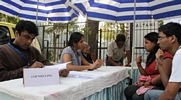Atrial fibrillation describes an irregular and often rapid heart rhythm. The irregular rhythm, or arrhythmia, results from abnormal electrical impulses in the heart. The irregularity can be continuous, or it can come and go. Normal heart contractions begin as an electrical impulse in the right atrium. This impulse comes from an area of the atrium called the sinoatrial (SA) or sinus node, the "natural pacemaker."
Atrial fibrillation is increasingly common with advancing age. During atrial fibrillation, the heart's two upper chambers (the atria) beat chaotically and irregularly — out of coordination with the two lower chambers (the ventricles) of the heart. The result is an irregular and often rapid heart rate that causes poor blood flow to the body and symptoms of heart palpitations, shortness of breath and weakness. Most people with atrial fibrillation have an increased risk of developing blood clots that may lead to stroke.
Causes
The heart has four chambers. The upper two chambers are the atria, and the lower two chambers are the ventricles. Blood returning to the heart from the body in the superior and inferior vena cava contains low levels of oxygen and high levels of carbon dioxide. This blood flows into the right atrium and then into the adjacent right ventricle. After the ventricle fills, contraction of the right atrium pumps additional blood into the right ventricle. The right ventricle then contracts and pumps the blood to the lungs where the blood takes up oxygen and gives off carbon dioxide. The blood then flows from the lungs to the left atrium and into the adjacent left ventricle.
Symptoms
Atrial fibrillation is a type of arrhythmia, in which the two upper chambers of the heart called the atria, quiver instead of beat effectively. This may result in rapid and irregular impulses in the atrium -- as fast as 300 per minute -- which typically causes a faster than normal and irregular ventricular rhythm.
You may have atrial fibrillation without having any symptoms at all. If you have symptoms, they may include:
* Heart palpitations (a sudden pounding, fluttering, or racing feeling in the chest).
* Lack of energy; feeling over-tired.
* Dizziness (feeling faint or light-headed).
Treatment
Medications are used to slow down rapid heart rate associated with AF. These treatments may include drugs such as digoxin, beta blockers (atenolol, metoprolol, propranolol), amiodarone, disopyramide, calcium antagonists (verapamil, diltiazam), sotalol, flecainide, procainamide, quinidine, propafenone, etc. Electrical cardioversion may be used to restore normal heart rhythm with an electric shock, when medication doesn't improve symptoms.
There are three classes of heart-function drugs that can be used alone, or in combination to reduce the heart rate. They are digitalis drugs, beta blockers drugs and calcium channel blocker drugs. Digitalis drugs such as digoxin (Lanoxin) are used to increase the force of heart muscles contractions, making the heart work more efficiently. They also slow down abnormally rapid nerve impulses as they pass through the atria to the ventricles. This action allows the ventricles time to fill up with blood and empty normally with each contraction. Beta blockers such as atenolol (Tenormin), metoprolol (Lopressor), or propranolol (Inderal) are used to slow heart rate and reduce the force of contraction of the heart muscle.



